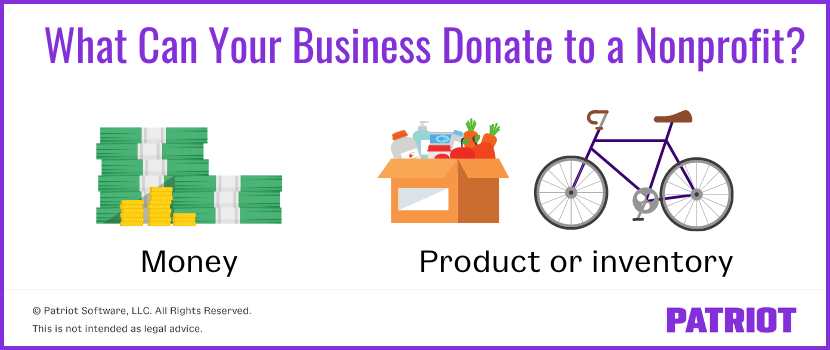Did your business make a donation? Are you thinking about making one? If your business is in the giving spirit and donates to a nonprofit, you need to make a donation expense journal entry. The way you record a donation expense journal entry differs depending on the types of donations you give.
So, what is the journal entry for donations? Read on to learn everything you need to know about how to record donations in accounting.
A quick word on debits and credits
Accounting for donations works the same as any other transaction. Even though you are donating and not making a profit, you still need to know how to debit and credit the appropriate accounts.
Debits increase asset and expense accounts and decrease equity, liability, and revenue accounts. Make debits on the left side of an account.
Credits increase equity, liability, and revenue accounts and decrease asset and expense accounts. Make credits on the right side of an account.
Debits and credits are like two sides of a scale. They are the opposite of each other and should always balance out. If you make a debit in one account, you must always make a credit in the opposite account.
With this in mind, let’s look at examples of donations your business can give and how donation journal entries can help.
Types of donations you can give
Donation types come in all different shapes and sizes. Here are a couple of the donation types you can give to a qualifying nonprofit organization:
- Cash
- Products and inventory
You must keep accurate records as you make your donations. And depending on the types of donations you give, the way you record donation expense journal entries can vary.
Keep reading to learn how to record donation expense journal entries for the different types of donations.

Donation expense journal entry
For accounting purposes, make sure to consider donations as nonoperating expenses. No profits are made when you make a donation.
For the following examples, donation expense journal entries take place in the general ledger.
1. Recording a cash donation
When your company makes a cash donation to a charitable organization, think of it as an outgoing bill in the name of the charity.
To do this:
- Set up the charitable organization as a new vendor
- Create an expense account dedicated to donations
- Record the cash donation as a check or bill in the name of the charity
Treat a cash donation as you would any other expense. Make sure to debit your Donation account and credit the appropriate Bank/Cash account.
For example, say your company donates $1,000 to a charity. Your journal entry should look like this:
| Date | Account | Debit | Credit |
|---|---|---|---|
| X/XX/XXXX | Donation | $1,000 | |
| Cash | $1,000 |
2. Recording a donation of products or inventory
If your company makes a noncash donation of products or inventory, you first need to understand the fair market value (FMV) of the donated items. Once you know the FMV of the items, create an:
- Invoice for the donated products or inventory
- Expense account for donations
- Accounting entry that represents the donated inventory as a “charitable contribution”
When you make a donation of your own products or inventory, keep in mind that you are giving away a product, not selling it. To record this type of donation, debit your Donation account and credit your Purchases account for the original cost of goods.
For example, your company donates $200 dollars worth of products to a charity. Here’s how to record this donation journal entry in your books:
| Date | Account | Debit | Credit |
|---|---|---|---|
| X/XX/XXXX | Donation | $200 | |
| Purchases | $200 |
Documenting donations
Documenting your donations helps keep your books properly organized in case of an audit. Documentation can also help if you want to claim deductions on your donations (more on this later). You can document donations with a:
- Receipt (for cash donations)
- Donation acknowledgment letter
- Letter of appraisal
- Completed Form 8283 (for donated property)
Generally, documentation must show the:
- Name and address of the nonprofit
- Date and location of the donation
- Value of the donation (and a description of the donation in the case of product or inventory)
Documenting cash donations
Cash donations can include donations made with cash, check, or a credit or debit card. Generally, to properly document a cash donation, the record of your donation must show the:
- Name of the charity
- Date of the donation
- Amount of the donation
If the cash donation is more than $250, you can use a canceled check or a business bank statement as documentation.
Documenting your donation of products or inventory
To properly document donations of products or inventory, find the product’s fair market value. The fair market value of a product is the amount you could have received for the product if you sold it for cash. The FMV isn’t necessarily the same price you paid for the product. Depreciation can lower the product’s FMV.
There are two ways to determine a product’s FMV. You can either:
- Look for the prices of similar products (keep in mind whether a product is used or new)
- Hire a professional appraiser
Deducting your donations
If you plan on making a charitable donation deduction after you give to a nonprofit, there are a few additional requirements you need to consider. Keep in mind that contributions to some nonprofits aren’t deductible.
Donations worth less than $250
If you plan on taking a deduction for a donation worth less than $250, make sure that you get a receipt or written confirmation from the charitable organization that describes the condition of the donation.
Donations greater than $250 and less than $500
If you plan on taking a deduction for a donation worth more than $250, make sure that you get a contemporaneous written acknowledgment. You must receive this acknowledgment before the date you file your return.
Donations greater than $500 and less than $5,000
If you plan on taking a deduction for a donation worth more than $500 and less than $5,000, fill out Form 8283 and get a contemporaneous written acknowledgment.
Donations greater than $5,000
If you plan on taking a deduction for a donation worth more than $5,000, fill out Form 8283 and get a contemporaneous written acknowledgment.
Need help keeping up with your accounts? Patriot’s accounting software helps you track your expenses and comes with free customer support. Try it for free today!
This is not intended as legal advice; for more information, please click here.



